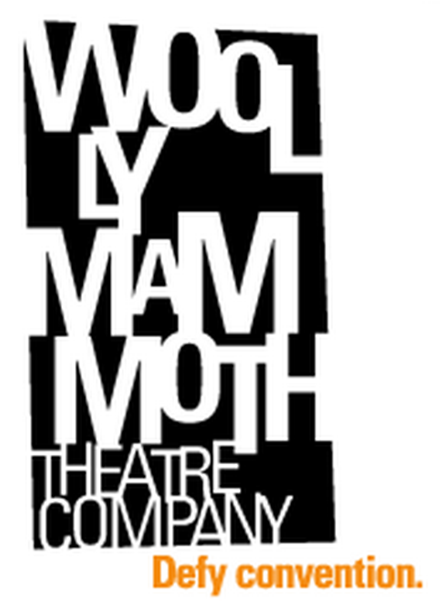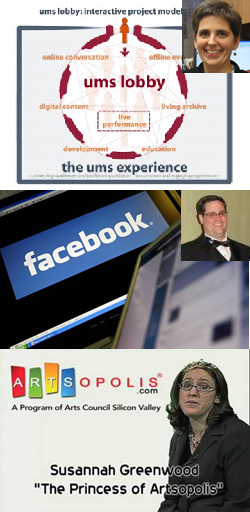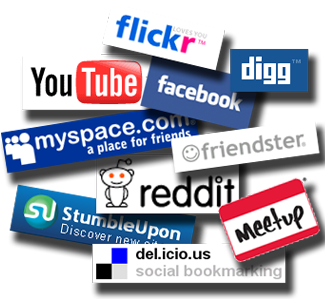As part of the 25th anniversary celebration of the arts management program here at CMU, we recently sat down with Douglas McLennan, founder and editor of Arts Journal, to talk about the role of blogs in arts organizations, how Arts Journal got its start, and some of the challenges facing the arts world as it seeks to develop new audiences. McLennan argues that true engagement can only occur when we first meet communities where they are, and that rather than telling our neighbors what they ought to appreciate, we must first listen to the troubles and triumphs that capture their attention.
9 Helpful Tips to Supercharge Your Digital Marketing: A free webinar for arts marketers!
Increasing online engagement, smarter budgeting for websites, banner ads that sell, and higher return rates on fundraising appeals; if any of the above caught your eye, you must be a digital marketer! And Technology in the Arts invites you to participate in a free webinar that will help you achieve these targets and enable your organization to Supercharge Its Digital Marketing!
 The webinar, which will take place on the 7th of August (1PM EST/10AM PST), is being held in partnership with Capacity Interactive, Opera America, The League of Resident Theatres, Dance NYC, and Technology in the Arts! It will be lead by Erik Gensler, the president of the digital marketing consulting firm, Capacity Interactive. In lieu of the upcoming webinar, we decided to ask Erik a series of questions pertaining to his views around digital marketing in the arts.
The webinar, which will take place on the 7th of August (1PM EST/10AM PST), is being held in partnership with Capacity Interactive, Opera America, The League of Resident Theatres, Dance NYC, and Technology in the Arts! It will be lead by Erik Gensler, the president of the digital marketing consulting firm, Capacity Interactive. In lieu of the upcoming webinar, we decided to ask Erik a series of questions pertaining to his views around digital marketing in the arts.
Having worked in this field for many years, what is your opinion on the general state of digital marketing in the arts?
I think organizations are evolving at different paces. Some organizations made a commitment to embrace digital marketing years ago and are now reaping the rewards. I find that the most successful organizations have senior leaders that allocated resources for staffing and budgets to focus on their website, embraced social media, and used digital media. Other organizations are still operating like it is 1995. Generally, larger organizations are faced with lesser difficulty when it comes to digital marketing while smaller organizations may rely on a junior staff person doing the best they can without the resources or support from senior management.
Overall, I do think that most people in the industry know that embracing digital marketing is important. It is hard to miss all of the reports about the growth of digital ad spending and how brands and organizations are thriving on social media. But success in digital marketing requires time, financial and personnel resources, and hiring people with the right skills.
Are arts organizations keeping apace with the technologies and tools out there?
I never advise organizations to chase the latest technologies because we've seen so many trends come and go. Let the for-profit world invest and experiment and once there is a proven ROI and user base and then consider jumping in if you think it is the right fit for your organization. First, focus on the fundamentals like your website, Facebook, and banner advertising. Then, focus on tools that have proven benefits rather than chasing "the latest technologies." Finally, focus your time where the majority of your audience or potential audience is and pay much less attention to the margins.
We are pretty sure that not all marketing campaigns are created equal. So are there any arts organizations that you think are doing an excellent job with their digital marketing?
I am impressed by many museums that were very bullish about embracing social media. The Brooklyn Museum for one is very innovative and forward thinking. They've had dedicated staff to focus on the digital arena for years! A few years ago Carnegie Hall made a big investment in their digital efforts and we are seeing some really great results like their mobile apps, a new website rich with content, and clever social campaigns. I am very proud of our work with Alvin Ailey American Dance Theatre, particularly on Facebook where they have grown a really strong and engaged community.
Some organizations, such as the MOMA, publish interactive content primarily on their website while others seem to rely more on Facebook or Twitter (ignoring their website in turn). What role does an organization's website play in a world so keen on social media?
I don't think the question is one versus the other but rather, both are important. In the early days of social media, we thought it was important to drive users from the social network back to your website. But now users can have a meaningful experience with an organization on its Facebook page or YouTube channel. It's also more likely that they access content through Facebook or YouTube as opposed to a website, so sharing compelling content on these mediums is crucial.
This isn't to say the content shouldn't also be on the website. In fact, the website is often the first place users go to have an experience with an organization digitally. So an organization needs to express its identity and mission on the site, and hopefully, entice its users into a relationship. Finally, it’s important to note that the website is what will persist, not matter what the latest social media fad may be.
With so many content driven social platforms, it can be difficult for an organization to retain interest and engagement. Would some organizations be better off focusing on their website or is a Facebook/Twitter/YouTube presence absolutely necessary?
I think if you have the content it would be a missed opportunity not to share it across these channels. This does mean more work for the marketing staff but ultimately, the potential reward can outweigh the effort. Organizations can also use syndication tools that help distribute content across platforms.
While online avenues to fundraising are becoming more prevalent, organizations still cite direct mailing campaigns as most effective in terms of response rate. Do you think that crowdfunding and reaching out through social media / email will eventually render mailing campaigns obsolete?
As more and more older people go online and generations that grew up using email and social media mature, there is no doubt that digital fundraising will wax as direct mail wanes. We are certainly not at a place where I would advise organizations to fully abandon direct mail. One big benefit of direct mail is that it doesn't require opting-in so that makes it advantageous for acquisition. Emailing someone without permission is spamming. Direct mail doesn't have that limitation and I think very few arts organization are completely comfortable with online fundraising so, as of now, an education gap does exist.
In a world of tablets and smartphones, mobile marketing is one to watch for! But what are some of the opportunities and challenges unique to this medium?
Across our clients' sites we are seeing up to 30% of traffic on mobile and tablets. The first thing organizations need to do is create a mobile friendly site or build their website using responsive design so the content renders properly on all devices. One opportunity that I see is in online advertising. Since the mobile ad space is less crowded, CPMs for pay-per-click on mobile are lower than desktops and the competition for keywords is much lower. Plus if you have a site enabled for mobile you can add calling your box office as a direct call-to-action and track these calls.
The nature of digital marketing is constantly changing, what are some of the innovations that you find particularly interesting?
What I love about digital marketing is that almost everything is measurable. I think we've come a long way when it comes to measurement and attribution modeling (attributing conversion credit to marketing channels). Now the standard for most platforms is to measure click-through and view-through conversions in advertising. This is quite useful in helping marketers understand what is working and then optimizing efforts.
I really like the new Google Analytics multi-channel funnel reports which let you see all the visits and sources that a user took before the purchase. I also think Facebook has made some good innovations in their Insights and Domain Insights. Yet they still have some way to go in terms of providing one single interface where you can see how your advertising, organic efforts, and domain insights are performing together. Right now you have to search through three separate areas and download into Excel to get any customized data.
Even so, I am excited for the innovations coming around measurement and analytics!
An interivew with Laura Quinn of Idealware: Helping Nonprofits Make "Smart Software Decisions"
Idealware is a nonprofit organization based in Portland, Maine. It helps other nonprofits make “smart software decisions” by offering recommendations on software products and vendors, and more importantly, on which of those products and vendors would best fit the organization’s specific needs. Idealware’s reports are plenty, thoroughly researched, relevant and up-to-date.
Photo 2.0 — Online Photographic Thinking with Andy Adams, Creator of Flak Photo
We have talked with cutting-edge professionals about Web 2.0, Museum 2.0, and Art 2.0 and shared their thoughts with you here. Now we bring you Photo 2.0, as understood and explained by the leading figure in the 21st-century, digital photography discussion. I spoke with Andy Adams, the creator and producer of Flak Photo, about Photo 2.0, communicating contemporary photography, the online art space, and 21st century image-making and sharing.
ArtStack: the Social Platform for Discovering Art through People
ArtStack, one of the newest social platforms for the visual arts, is growing in popularity all over the word. I spoke (Q) with Ezra Konvitz (K), co-founder of Artstack, to find out how it differentiates from other widely popular image-sharing platforms, such as Pinterest, and how arts professionals can benefit from it. ArtStack celebrates the process of discovering artwork in a truly empowering way for each user. But what makes ArtStack uniquely different from other platforms, like Pinterest, is the composition and intentions of its population.
Technology in Art and Arts Organizations: Interview with Fifth House Ensemble
Integrating technology, on any level, can be daunting for arts organizations. There are valid trepidations concerning cost and time commitments, and generally a change resistance culture. You won’t find that attitude with Melissa Snoza and the staff of Fifth House Ensemble.
Podcast Episode #84 - Social Media Spotlight: Woolly Mammoth Theatre Co.
 Woolly Mammoth Theatre Co. in Washington, DC has been getting a lot of press lately about their re-launch of the Pulitzer-Prize winning play "Clybourne Park". Along with the production, Woolly Mammoth has begun an innovative audience engagement campaign that includes many social media platforms. In this podcast, Rachel Grossman (Connectivity Director for the theater) answers questions about social media planning, what "connectivity" actually means, and integrating efforts across platforms.[display_podcast]
Woolly Mammoth Theatre Co. in Washington, DC has been getting a lot of press lately about their re-launch of the Pulitzer-Prize winning play "Clybourne Park". Along with the production, Woolly Mammoth has begun an innovative audience engagement campaign that includes many social media platforms. In this podcast, Rachel Grossman (Connectivity Director for the theater) answers questions about social media planning, what "connectivity" actually means, and integrating efforts across platforms.[display_podcast]
Podcast Episode #82 - Tech Tips for Small Arts Organizations
 In this episode, the Technology in the Arts team discuss 10 tech tips to help small arts organizations maximizing their effectiveness while minimizing the impact on their budgets.
Topics include: all things Google, free broadcast email, social media strategy, establishing a mobile presence, using Facebook as your brand, location-based social media platforms, TechSoup Global, and more!
In this episode, the Technology in the Arts team discuss 10 tech tips to help small arts organizations maximizing their effectiveness while minimizing the impact on their budgets.
Topics include: all things Google, free broadcast email, social media strategy, establishing a mobile presence, using Facebook as your brand, location-based social media platforms, TechSoup Global, and more!
Cool Sites of the Episode:
Podcast Episode #76 - Virtual Lobbies, Facebook Advertising Strategy, and Online Marketing Hits and Misses
 In this second podcast episode in a three-part series (1 | 3) featuring interviews from the National Arts Marketing Project conference, we talk with three arts professionals about their marketing successes (and some misfires).
We lead off the episode with Amelia Northrup interviewing Sara Billman from the University Musical Society about the UMS Lobby - a virtual space, accessible year-round, where UMS offers multiple streams of engagement activities.
In this second podcast episode in a three-part series (1 | 3) featuring interviews from the National Arts Marketing Project conference, we talk with three arts professionals about their marketing successes (and some misfires).
We lead off the episode with Amelia Northrup interviewing Sara Billman from the University Musical Society about the UMS Lobby - a virtual space, accessible year-round, where UMS offers multiple streams of engagement activities.
Next up, David Dombrosky talks with Robert Gore from Theatre Development Fund (TDF) about strategic tips for success with Facebook ads. These tips are simple and easy for any arts organization to implement.
Finally, Amelia wraps up the episode by interviewing the Susannah Greenwood (aka The Princess) of Artsopolis, the Silicon Valley’s ultimate online guide to arts and culture, about the various online marketing strategies that Artsopolis has employed (both successful and not-so-much) as well as ways to engage Gen Y audiences.
Podcast Episode #70 - Discussion of "Theatre & Social Media in 2009" with Devon Smith
 In this episode of the Technology in the Arts podcast, CAMT marketing assistant Pat Germann interviews Devon Smith, director of research and analysis for Yale Repertory Theatre, about her recent report "Theatre & Social Media in 2009."
Devon Smith holds an MBA from Yale School of Management, an MFA in Theatre Management from the Yale School of Drama, a Bachelors of Business Administration and a Bachelors of Arts from the University of Washington. She is a long time nonprofit manager, social media addict, and has developed a burgeoning interest in cinematography and world travel. With a voracious appetite for blogs & books, she is currently in pursuit of a fabulous, high paying, soul-fulfilling job that combines all of her interests–or, you know, anyone willing to actually hire her.
In this episode of the Technology in the Arts podcast, CAMT marketing assistant Pat Germann interviews Devon Smith, director of research and analysis for Yale Repertory Theatre, about her recent report "Theatre & Social Media in 2009."
Devon Smith holds an MBA from Yale School of Management, an MFA in Theatre Management from the Yale School of Drama, a Bachelors of Business Administration and a Bachelors of Arts from the University of Washington. She is a long time nonprofit manager, social media addict, and has developed a burgeoning interest in cinematography and world travel. With a voracious appetite for blogs & books, she is currently in pursuit of a fabulous, high paying, soul-fulfilling job that combines all of her interests–or, you know, anyone willing to actually hire her.
Read the full report (PDF 5.8 MB) >>
Visit Devon's blog: http://www.devonvsmith.com
[display_podcast]








